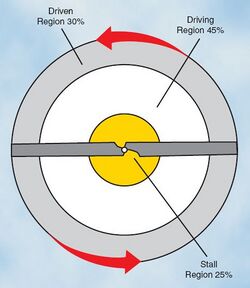Asymmetry of lift
Topic: Physics
 From HandWiki - Reading time: 2 min
From HandWiki - Reading time: 2 min
Asymmetry of lift describes an aspect of the nature of aerodynamic lift generation along the length of an individual rotor blade of a helicopter.
The phenomenon is most easily envisaged when a helicopter is hovering, that is, maintaining a fixed position above a fixed point, and with no wind in the atmosphere.
A helicopter rotor blade is an aerofoil, acting like the wing on an aeroplane being driven through the air to create lift. In the case of a fixed-wing aircraft in normal flight, the entire wing travels forward through the air at the same speed. In the case of helicopter rotor blades, the tips of the blade travel very fast through the air while the parts near the rotor hub travel much more slowly. Because lift increases with speed, the outermost sections of the rotor blades generate more lift than those parts closer to the rotor hub. So a rotor blade is said to be an aysmmetric generator of lift, because of the difference in lift generated along its length.
Helicopter manufacturers try to reduce this differential effect (that is, aim for more equality of lift along the blade length). This has two main aspects:
- tapering a blade toward its tip, which reduces its surface area, in turn reducing its lift;
- twisting the blade (commonly called geometric twist) so that the blade root near the hub presents a higher angle-of-attack, thus higher lift.
When the helicopter is travelling forwards with respect to the atmosphere, a further phenomenon comes into play, dissymmetry of lift.
References
 KSF
KSF
